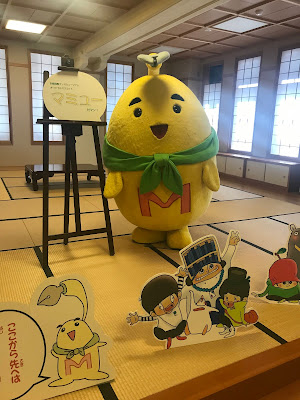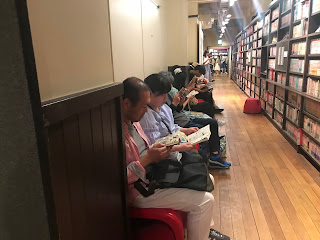 |
| MAMYU, the museum's mascot available for photo opportunities |
As lifelong comics fan and gold-standard nerd, I'd been looking forward to visiting the Kyoto International Manga Museum. Maybe a little too much. It boasts a collection in excess of 50,000 manga titles which create several walls of manga that stretch over 200 meters throughout the former Tatsuike Primary School. For bibliophiles it might be enough to see the shelves curving around the building or see Japanese visitors of all ages sitting reading their favourites. But the 'international' titles are restricted to a range of translations in the bookshop and a few examples of manga's influence with international books (including Australia's own Queenie Chan). Japanese manga is so popular that it almost doesn't need translation into English.
 |
| Reading up on the extensive Wall of Manga |
There are great exhibitions which are bilingual. The Manga Hall of Fame, for example, draws together some of the great manga titles since 1945 with text panels detailing the best of each era. The comfy Children's Library was a great place to laze but mostly had Japanese titles.
 |
| Kamishibai bike including screen mounted on top featuring Ogon Bat |
Some of the best things for non-Japanese visitors were visual like the Cosplay on the lawn (Saturdays only) and the kamishibai man. Born out of pre-television Twentieth Century, the kamishibai (roughly translated as 'paper story') would ride bicycles between towns and clap blocks of wood together to signal the start of the show. At the museum they mimic this with kamishibai man walking and shouting to start the show. Using picture frame, kamishibai tells stories (we were lucky enough to see Ogon Bat, often called the first Japanese superhero) by shuffling through pictures and employing some over-the-top dramatics. It was so popular that when television was introduced it was initially known as electric kamishibai. In our show the jokes were visual so they translated well and the performer worked hard to make lively so our kiddo laughed along regardless of language.
 |
| The hand of Moebius |
An interesting temporary exhibit was a series of plaster cast hands of Manga artists who had visited the museum, which had famous inclusions like Moebius (Jean Giraud) the French comic artist best known for his Western Blueberry and contributing aesthetics for Tron and Alien. It was set in an old classroom complete with old-school blackboard that gave it an added reverence. There were lots of creators I only vaguely knew. There were some good chances to interact - making your own characters and watching manga artists at work - though it felt like this was one for the fans rather than for everyone.
Tips for visiting

- There's a manga portrait service that you can book on the day but books out towards the end of the day. It takes 20 minutes per person (so 40 minutes for 2 people, 60 for 3) so it will add more time to your visit. The workshops are also worth booking ahead for especially if you have a larger group.
- Plan on spending 1-3 hours here depending on your interest in manga and your level of Japanese.
- There's a strict no-photography policy throughout but they almost know that it's impossible to enforce so they have a few stations where you can get a selfie (for example with MAMYU the mascot).









Comments
Post a Comment